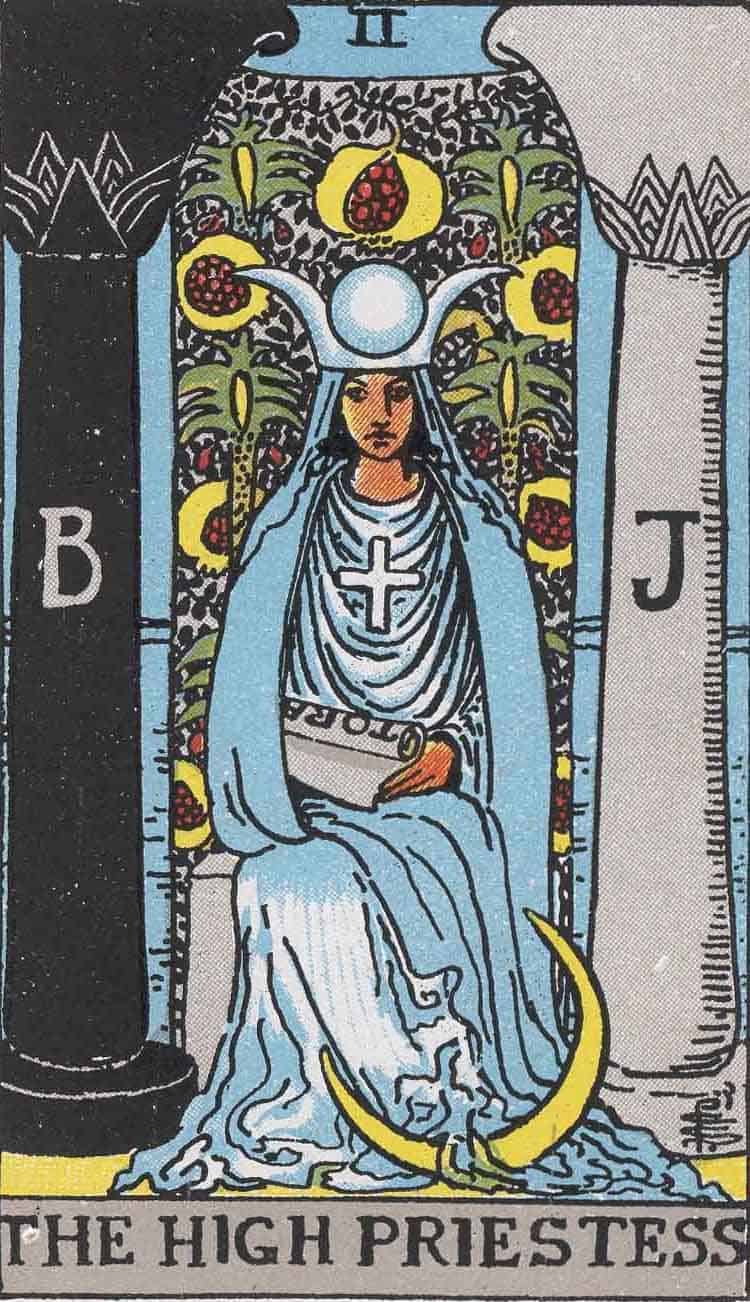
The High Priestess – The Tarot: Major Arcana
After encountering the Magician and learning his masculine principle of acting on one’s spiritual beliefs, we meet his counterpart, the High Priestess, who in many ways represents the feminine principle of receptivity to spirit.
The High Priestess is the second card in the major arcana, and in earlier playing card decks was titled the Papess, meaning “female pope”. There is also a male pope in the deck, originally simply titled Le Pape or “The Pope”, referred to today as the Hierophant. They are considered counterparts, with their connection sometimes implied through the coloration of their garments, with the Marseille version depicting the Papess wearing a blue cape and red robe and the pope wearing a red cape with a blue robe.
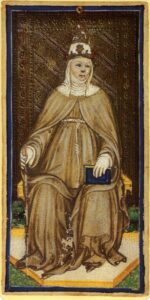
(pictured: The Visconti-Sforza Tarot)
The Visconti-Sforza tarot, known as the earliest surviving tarot card deck in existence, chose to depict Sister Maifreda, an Umiliata nun and a relative of the Visconti family, as the High Priestess. Maifreda was a devotee of Gugglielma of Bohemia, a European noblewomen who led a movement towards a more feminized version of Christianity. Gugglielma preached that the end of the world was near and that following her death, she would be resurrected as the Holy Spirit incarnate and usher in a new era of female popes. She herself passed away sometime between 1279 and 1282, and Maifreda was elected pope of the Gugglielmites. We can see that paying card versions of the Papess notably emphasize authority, with her ornate crown signifying her elected status and dedication to a life with Christ. As the year 1300 passed without Gugglielma’s return, the Inquisition took action, burning her and several of her disciples at the stake. However the Papess remained a staple of tarot decks published after this time, becoming associated with other representations of the divine feminine such as the Virgin Mary, Isis, and Juno. There are also many people who link her to Pope Joan, a woman who, according to legend, disguised as a man in order to ascend to the papacy and was only discovered to be female when she gave birth.

(pictured: The Rider-Waite Tarot)
When Arthur Edward Waite conceived his version of the High Priestess for the Rider-Waite Tarot, he removed most explicit references to her being an elected official (though the cross remains) and emphasized her divine feminine qualities. If we consider the number 1 of the Magician card being a phallic symbol emerging from the nothingness of the Fool (0), the roman numeral for 2 (II) can be seen as a representation of the opening of the womb, further showing how the Magician and High Priestess are counterparts to one another. We also see this imagery expressed through a reference to the pillars at the entrance of the Temple of Solomon, Boaz and Jachin. In the Rider-Waite image, we see the pillars depicted behind her, flanking either side. On the left we see a black pillar marked B for Boaz and on the right we see a white pillar marked J for Jachin. In between the pillars is a curtain decorated with pomegranates and palm leaves – another reference to the merging of the phallus and the womb and a foreshadowing of motifs present in the third major Arcana card The Empress. The Empress card itself depicts a pregnant woman – the probable end result of the implied sexual union between the High Priestess and the Magician – wearing a dress adorned with pomegranates.
The pomegranates on the curtain are also a reference to the goddess Persephone, queen of the underworld. The High Priestess is a master of descending through the depths of our subconscious to find the parts of ourselves we keep hidden, so this connection makes sense. This symbolism also gives us a clue about what lies behind the curtain. As a symbol for an entrance to a temple, we are to infer that spiritual wisdom lies between the two pillars. Interestingly, the curtain does not completely hide what lies beyond – we can make out ocean water coming up to shore if we peek through the sides. This may be suggesting that the mysterious spiritual wisdom we seek from other higher sources could already be apparent to us if we simply acknowledged it. The scroll held in the High Priestess’s lap is labeled “TORA” (“divine law”) and is a symbol of the memory we carry inside about the past, present and future.
Waite also introduced visual references to the moon in his version of the card, with a crescent moon at the base of the Priestess’s feet and triple moon symbol on her crown (this is also seen as a reference to the goddess Hathor, whose own crown was made up of the horns of a cow). Waite himself considered his Priestess to be a nod to the Hellenistic goddess Astarte who was strongly associated with the moon. The moon is a universal symbol of the divine feminine with menstruation being tied to moon cycles, so its placement here is appropriate.
From this we have a basic archetype that the querent can interpret in relation to most topics/situations. Because the High Priestess is a symbol of the divine feminine, when you pull the card in a reading, you might ask “what is my relationship to femininity in this circumstance?”. Being seated as opposed to standing, she also raises the question “Am I allowing myself to perceive events as they unfold, or am I rushing to conclusions?” Yet another way to look at her is as a symbol of the wisdom we already have available to us: “How can my own innate wisdom be utilized in this situation to accomplish my goals?” The answers will be different depending on the context of the reading, but her essence remains the same no matter which deck you pull her from.
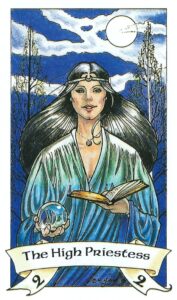
(pictured: The Robin Wood Tarot)
For an example, let’s look at the High Priestess in the Robin Wood Tarot, a classic beginner deck with many tropes borrowed from the Rider-Waite. In this version we see a more minimal approach being taken with the imagery. Gone are the pillars of the Temple of Solomon, and in its place are two trees – one white, one black – which now serve as the entrance to the ethereal realm. The Tora has been replaced by a spellbook and a crystal ball to denote her spiritual wisdom. She is still draped in a long flowy dress, but she is now standing instead of being seated, adding a quality of action to this depiction. We also see the full moon shining brightly above her head, standing in for the lunar imagery depicted in the Rider-Waite card. This absence of obscure religious symbolism in this version of the High Priestess makes it more accessible to beginners, who will likely have no familiarity with the Temple of Solomon, pomegranate symbolism, or the content of the Tora, but presumably will be able to connect to the qualities of intuition and femininity that are depicted in more obvious ways (via the moon, a book, a crystal ball, and her traditionally femme presentation).
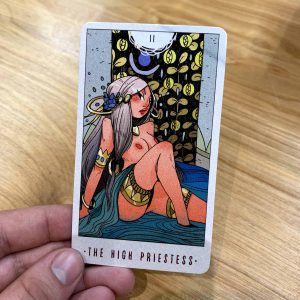
(pictured: The White Numen Tarot)
Let’s look at another example: In the White Numen Tarot, the High Priestess sheds her garments completely so she can take a dip in the ethereal waters. This takes the quality of mystery typically attributed to the card and turns it on its end. Here, she is depicted as being approachable, expressive, and confident in herself. The curtain with the pomegranates from the RWS remains, without the glimpse of what lies beyond, warning the querent not to ask questions they don’t want the answers to. Taking a cue from the water’s quality of passivity, we are asked to be patient and look within for answers as opposed to rushing headfirst towards them. We also see a representation of the moon above her head, but this time it has been united with the symbol for the sun, implying that this High Priestess has already found harmony, without needing a complementary male figure. She is both yin and yang, masculine and feminine, active and receptive.
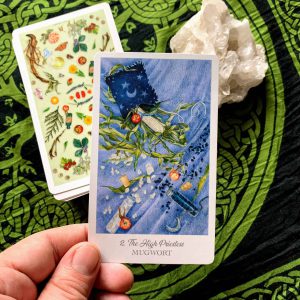
(Pictured: The Herbcrafter’s Tarot)
Finally, let’s examine a non-human portrayal: In the Herbcrafter’s Tarot by Latisha Guthrie and Joanna Powell Colbert, human figures have been replaced by various botanicals to illustrate the qualities of each card. In the High Priestess, the qualities of mystery and intuition are represented by mugwort, a plant that is often called upon to enhance dreams and inner visions. In the image we see an assortment of ingredients being used to construct a dream pillow. There’s a star-and-moon emblazoned pouch half-sewn filled with mugwort, along with a tied-up scroll (likely a nod to the TORA), a silver moon pendant (tying in with the moon imagery found in the Rider depiction), fresh-cut rosehips and bottles of copal and storax resin. The importance of connecting to one’s subconscious for insight is writ large here, and the lack of a human figure makes it easier for readers of all backgrounds to connect to the card’s message.
However you choose to work with the High Priestess, her presence in a reading is a sure sign to slow down, trust in your connection to the divine, and look within for insight. You may be surprised to discover that you already had access to the information you were seeking!
The decks pictured above can all be found at our brick-and-mortar store in Northampton, MA as well as online at inspiritcrystals.com/shop!
Sources
- Tarot Heritage
- Tarot Wisdom by Rachel Pollack
- Tarot Deciphered by T. Susan Chang and M.M. Meleen